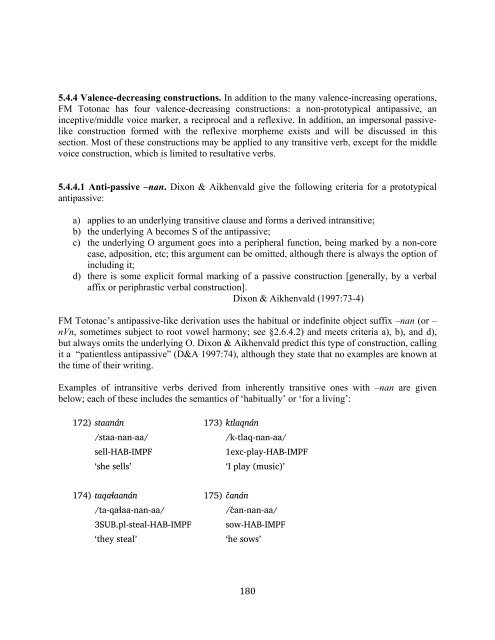The phonology and morphology of Filomeno Mata Totonac
The phonology and morphology of Filomeno Mata Totonac
The phonology and morphology of Filomeno Mata Totonac
You also want an ePaper? Increase the reach of your titles
YUMPU automatically turns print PDFs into web optimized ePapers that Google loves.
5.4.4 Valence-decreasing constructions. In addition to the many valence-increasing operations,<br />
FM <strong>Totonac</strong> has four valence-decreasing constructions: a non-prototypical antipassive, an<br />
inceptive/middle voice marker, a reciprocal <strong>and</strong> a reflexive. In addition, an impersonal passivelike<br />
construction formed with the reflexive morpheme exists <strong>and</strong> will be discussed in this<br />
section. Most <strong>of</strong> these constructions may be applied to any transitive verb, except for the middle<br />
voice construction, which is limited to resultative verbs.<br />
5.4.4.1 Anti-passive –nan. Dixon & Aikhenvald give the following criteria for a prototypical<br />
antipassive:<br />
a) applies to an underlying transitive clause <strong>and</strong> forms a derived intransitive;<br />
b) the underlying A becomes S <strong>of</strong> the antipassive;<br />
c) the underlying O argument goes into a peripheral function, being marked by a non-core<br />
case, adposition, etc; this argument can be omitted, although there is always the option <strong>of</strong><br />
including it;<br />
d) there is some explicit formal marking <strong>of</strong> a passive construction [generally, by a verbal<br />
affix or periphrastic verbal construction].<br />
Dixon & Aikhenvald (1997:73-4)<br />
FM <strong>Totonac</strong>’s antipassive-like derivation uses the habitual or indefinite object suffix –nan (or –<br />
nVn, sometimes subject to root vowel harmony; see §2.6.4.2) <strong>and</strong> meets criteria a), b), <strong>and</strong> d),<br />
but always omits the underlying O. Dixon & Aikhenvald predict this type <strong>of</strong> construction, calling<br />
it a “patientless antipassive” (D&A 1997:74), although they state that no examples are known at<br />
the time <strong>of</strong> their writing.<br />
Examples <strong>of</strong> intransitive verbs derived from inherently transitive ones with –nan are given<br />
below; each <strong>of</strong> these includes the semantics <strong>of</strong> ‘habitually’ or ‘for a living’:<br />
172) staanán 173) ktlaqnán<br />
/staa-nan-aa/ /k-tlaq-nan-aa/<br />
sell-HAB-IMPF 1exc-play-HAB-IMPF<br />
‘she sells’ ‘I play (music)’<br />
174) taqa"aanán 175) c%anán<br />
/ta-qa#aa-nan-aa/ /c"an-nan-aa/<br />
3SUB.pl-steal-HAB-IMPF sow-HAB-IMPF<br />
‘they steal’ ‘he sows’<br />
! ",.!

















